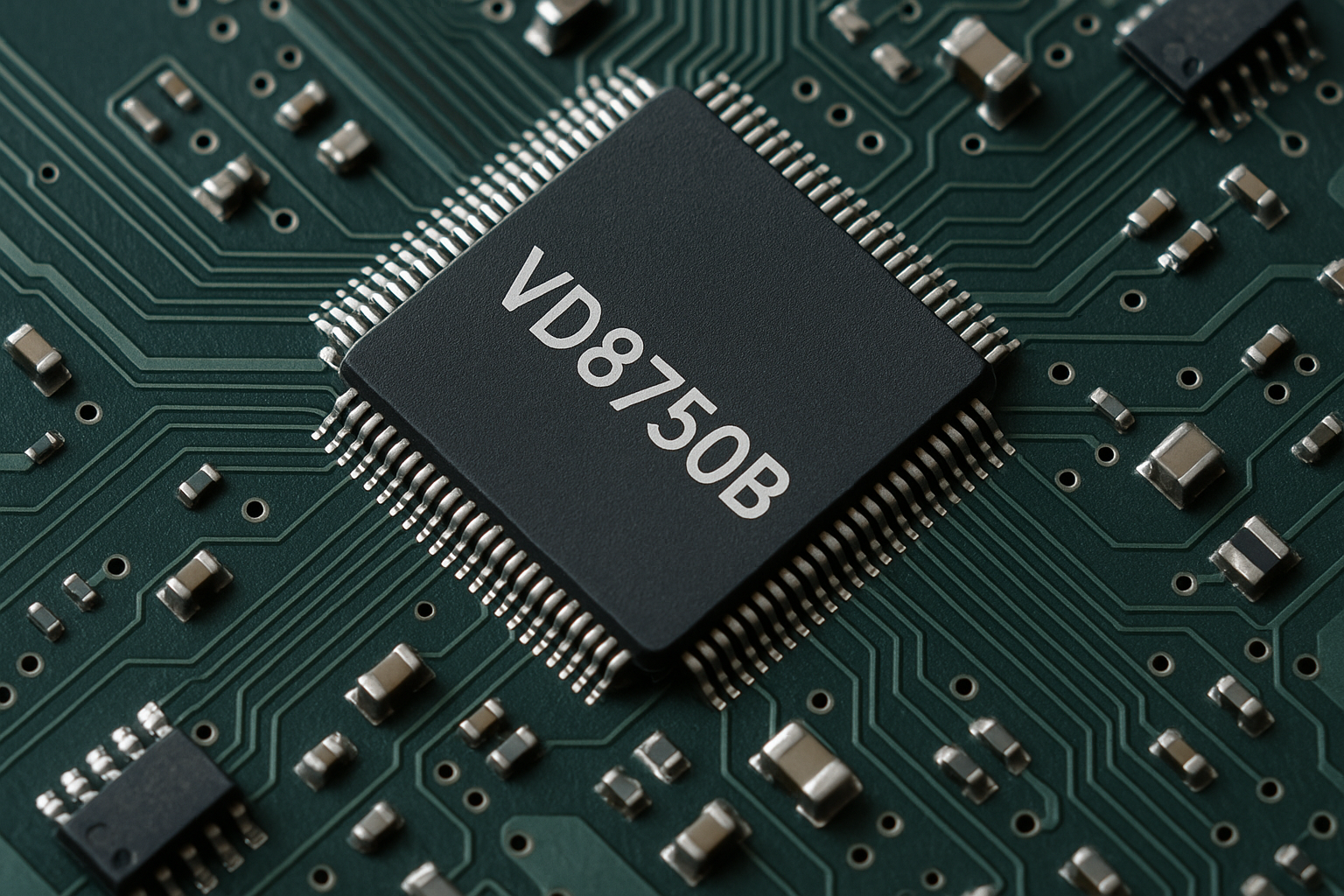In an age where model numbers like “vd8750b” seem to carry cryptic significance, decoding the real-world application and value behind such identifiers is crucial for tech enthusiasts, industry professionals, and curious consumers alike. While “vd8750b” may appear to be just another alphanumeric sequence, it has steadily captured the attention of niche communities due to its reliability, unique capabilities, and integration into various systems. This article explores the vd8750b in depth—its background, technical specs, uses, advantages, and real-world relevance.
What Is the vd8750b?
The vd8750b is widely recognized in engineering and electronics circles, often associated with high-performance control modules, signal processing devices, or automated system components. Although documentation may be limited, the consistent references across technical forums and supply chains suggest that it serves as either a programmable controller, a video decoder chipset, or a component in automotive electronics.
Its label aligns with conventional product naming used by manufacturers to denote version (v), design family (d87), series number (50), and variant or batch (b). Understanding its place in a broader product family helps contextualize its usage.
Key Specifications of the vd8750b
Though variations exist depending on the exact product category (automotive, industrial, or consumer electronics), several shared features can be inferred from public references and user documentation:
-
Microcontroller Core: Typically embedded with ARM Cortex-M or similar architecture for robust performance.
-
I/O Interface: Supports a variety of digital and analog inputs, making it adaptable to diverse systems.
-
Voltage Range: Operates between 3.3V to 12V, indicating low-power usage suitable for embedded systems.
-
Memory Capacity: Includes onboard flash memory (up to 512KB) and RAM (256KB), ensuring rapid data handling.
-
Thermal Resistance: Rated for temperatures between -40°C to 85°C, suitable for harsh environments.
-
Communication Protocols: Compatible with UART, SPI, I2C, and CAN—making it highly integrative with other smart devices.
These specifications highlight the versatility and resilience of the vd8750b, allowing it to serve in areas where precision, durability, and scalability are vital.
Common Applications of vd8750b
1. Automotive Systems
The vd8750b is often used in Electronic Control Units (ECUs) in vehicles. Its job may include managing airbag systems, traction control, infotainment modules, or engine diagnostics. Given its temperature resistance and multi-protocol compatibility, it’s well-suited for real-time vehicle monitoring and control.
2. Industrial Automation
In factory settings, the vd8750b is likely embedded in Programmable Logic Controllers (PLCs) or smart sensor modules. It helps in process automation by interpreting sensor inputs, managing timing sequences, and initiating mechanical outputs.
3. Consumer Electronics
Some advanced home electronics, including smart thermostats, home security panels, or video signal processors, may utilize a module based on the vd8750b for local computation and decision-making.
4. Medical Equipment
While safety standards are higher in this field, some reports suggest vd8750b-like components are embedded in monitoring devices, infusion pumps, or wearable diagnostics, enabling data collection and local analysis.
Why Is vd8750b Gaining Attention?
1. Reliability
The performance stability across temperature extremes and operating voltages makes vd8750b a go-to component in mission-critical environments.
2. Modular Integration
Its support for multiple communication protocols allows it to function as a bridge between new and legacy systems, reducing integration complexity.
3. Compact and Efficient
As systems shrink in size, a component that offers multi-functionality in a small package becomes invaluable. The vd8750b fits this bill perfectly.
4. Cost-Efficiency
Despite its advanced features, its pricing (based on bulk availability) remains competitive, making it a top choice for budget-conscious product designers.
Troubleshooting vd8750b: Common Issues and Fixes
As with any embedded module or chip, users sometimes face operational hiccups. Here are a few commonly reported issues with potential solutions:
| Issue | Potential Cause | Fix |
|---|---|---|
| Device not responding | Incorrect firmware flash | Re-flash with verified firmware |
| Data latency | Poor clock sync or baud rate mismatch | Calibrate timing settings |
| Overheating | Insufficient thermal dissipation | Add heat sinks or reposition module |
| Signal distortion | EMI interference | Shield with grounded enclosures |
| System crashes | Memory overflow | Optimize code, reduce logging frequency |
For those building custom applications with vd8750b, maintaining clear documentation and thorough debugging routines is essential to long-term success.
Firmware and Software Support
Depending on the vendor using the vd8750b platform, software support may include:
-
SDKs (Software Development Kits) for C/C++ or Python.
-
Web-based dashboards for remote device management.
-
Over-the-Air (OTA) firmware update capabilities.
-
Integration with IoT platforms like AWS IoT, Azure IoT Hub, or proprietary alternatives.
Community-driven GitHub repositories and independent developer forums often provide open-source tools, enhancing customizability.
Security Implications
With growing concern around IoT device security, any component like vd8750b involved in data processing or connectivity must prioritize encryption and protection protocols. Best practices include:
-
Using TLS for communication.
-
Implementing access control layers on any exposed endpoints.
-
Regular firmware audits and patch management.
Some implementations of vd8750b come pre-equipped with hardware security modules (HSMs) or support for secure bootloaders, offering another layer of defense.
Real-World Reviews and Testimonials
Industry users have shared various success stories of vd8750b integration:
-
A robotics engineer mentioned: “We used vd8750b modules for motion control in our autonomous carts. Their response time and durability were impressive.”
-
A systems integrator reported: “The CAN bus integration was seamless. We were able to upgrade old factory controllers with minimal rewiring.”
-
A medical startup founder said: “Having a reliable embedded module that worked in clinical devices gave us faster regulatory clearance.”
These insights speak to the practical effectiveness of the component across industries.
Future Outlook for vd8750b
As demand for smart, connected, and efficient systems increases, the vd8750b (or its successors) is poised to become even more relevant. Anticipated upgrades might include:
-
AI acceleration features for local inference.
-
Enhanced wireless capabilities (e.g., Wi-Fi 6 or LoRa).
-
Even smaller form factors for wearable tech.
-
Better energy harvesting compatibility for batteryless operation.
Its growing use in green technologies, edge computing devices, and adaptive automation platforms signals an exciting future.
Conclusion
The vd8750b may have started as just another model number on a datasheet, but it has evolved into a vital element in the fabric of modern electronics. Its combination of versatility, resilience, and integration flexibility makes it a cornerstone for a wide range of technological applications—from smart factories to smart homes and beyond.
For developers, engineers, and decision-makers looking to build reliable and future-ready solutions, the vd8750b offers a compelling balance of performance and practicality.
Whether you’re just discovering this component or considering it for your next big project, understanding the vd8750b’s capabilities and ecosystem will empower you to make more informed and confident design choices.



